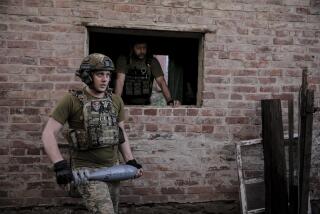Let Both Nations Share the Peace-Dividend Pie : Arms control: Write four lines of deck to supplement information in the head, and end it with a paragraph symbol.and add one more line.
- Share via
The United States and the Soviet Union appear to be moving in a timely manner toward significant reductions in strategic nuclear forces. Indeed, the successful meeting of Presidents Bush and Gorbachev at Malta opened prospects for broadening the network of cooperation between our two countries in economic as well as security and arms-control matters. Perhaps we should now explore possibilities for arms reductions that combine immediate and direct security benefits with cooperative economic gains for both countries.
In the past, one country or the other has frequently been in the position of spending money to expand or modernize its forces in order to strengthen its bargaining position at the negotiating table. It would save a lot of time and money to negotiate a force reduction that both countries desire before investing in such a build-up.
In order to make such an agreement more balanced and attractive, the money saved by the country that was no longer obliged to complete an expensive missile modernization program could then be applied to the benefit of both countries. For example, we could negotiate to remove land-based ICBMs that are both mobile and armed with multiple warheads. Many analysts have endorsed a ban on such systems, which are destabilizing as well as difficult to verify. However, the United States has just started to convert our existing MX multiple-warhead missiles to a mobile force that will match a similar one already deployed by the Soviet Union. Instead of waiting until that conversion has been completed, we should cut a deal now for their removal, applying the money we save to balance the benefits for both parties.
A few years ago, it would have been impractical to propose economic cooperation in order to balance asymmetries in the reduction of military forces. But the extraordinary progress in East-West relations has given us hope that, moving beyond the Cold War, we might now succeed in achieving a balance. An excellent opportunity presents itself in the matter of land-based mobile ICBMs.
The fixed, silo-based ICBM forces of both the United States and the Soviet Union are perceived as growing increasingly vulnerable to destruction. This vulnerability arises from two developments: Intercontinental missiles are now MIRVed--armed with multiple warheads that can be independently delivered at one or more targets. And these warheads have achieved a high degree of accuracy. This combination leads to the possibility--and threat--that an attacker might have to use only one of his warheads (perhaps two) to destroy the warheads (as many as 10) on one MIRV-augmented missile housed in a single hardened underground silo.
In order to reduce this threat, both countries have initiated very costly modernization programs for their ICBM forces. These programs have two components. One is to develop small, single-warhead ICBMs, identified as the Soviet SS-25 already in deployment, and the U.S. Midgetman currently under development. Thus both forces would be mobile. Also, the United States has undertaken a program to remove its 50 MIRVed MX missiles from their individual silos and deploy them as a rail-mobile force, as the Soviet Union has done with its MIRVed SS-24s.
Putting aside operational complexities and added costs, mobile basing of these missiles raises serious concern about the ability to verify compliance with negotiated limits on the number deployed. The verification challenge for mobile basing is more difficult than simply counting silos; the means are annoyingly more intrusive and considerably more expensive. Concerns about accuracy in the count are intensified by the fact that, whatever the uncertainty on numbers of missiles, the uncertainty on numbers of threatening warheads is, for the SS-24 and the MX, 10 times larger.
This latter concern has led a broad spectrum of strategic analysts from both countries to urge a ban on deployment of these ICBMs in future negotiations on strategic arms. Such a ban is likely to be one of the goals in the next round of START. At that time, however, there will still be a large asymmetry between the two ICBM forces. Numerically they will be comparable, but Soviet SS-24s are already deployed--at considerable expense--as a rail-mobile, highly survivable force. In 1991, the United States will still be in the very early stages of constructing a rail-mobile system for its 50 MXs, which are now based in highly vulnerable underground silos.
Will the United States be compelled to spend many billions of dollars and complete a rail-mobile deployment in order to establish symmetry before we can negotiate a draw-down (or return to silo basing)? Or can we negotiate a cut in the existing forces and, at the same time, establish an overall quid pro quo with the Soviets by putting the money saved to our mutual economic benefit? The reduction in numbers of missiles and warheads would be identical for both countries. The asymmetry would lie only in what the Soviets have already spent to deploy a more survivable mobile-basing scheme. It is these costs that would be compensated by a mutually beneficial economic deal.
Many possibilities for establishing such a quid pro quo suggest themselves. One might involve funding for a joint technology program to develop and build “inherently safe” nuclear reactors for clean power. Three-Mile Island and Chernobyl are grim reminders that both countries have serious needs in this area; and the ominously looming problems of environmental damage, including global warming, caution us that safe, clean and economical power for the developed and developing nations is a very high priority issue for all.
There are many other areas of economic collaboration that may be more practical, such as industrial modernization, improvement of the very inefficient system for food distribution in the Soviet Union and expanded job retraining programs in non-defense industries for both countries.
The attractiveness of this simple scheme is that both countries reduce their forces equally in order to achieve a mutually desirable goal. Time, effort and money are all saved by implementing these reductions before both systems are fully converted to a more survivable basing, and any asymmetric financial advantages realized thereby can be applied to the economic advantage of both parties.
The economic cooperation that this calls for no longer seems so visionary as to be dismissed as impractical.
More to Read
Sign up for Essential California
The most important California stories and recommendations in your inbox every morning.
You may occasionally receive promotional content from the Los Angeles Times.










